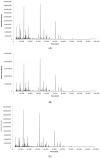Chemical Composition of Pyroligneous Acid Obtained from Eucalyptus GG100 Clone
- PMID: 29462854
- PMCID: PMC6017387
- DOI: 10.3390/molecules23020426
Chemical Composition of Pyroligneous Acid Obtained from Eucalyptus GG100 Clone
Abstract
The present study aimed to characterize the chemical composition of pyroligneous acid (PA) obtained from slow pyrolysis of the clone GG100 of Eucalyptus urophylla × Eucalyptus grandis. The efficiency of extraction of organic compounds by using different solvents-dichloromethane (DCM), diethyl ether (DE) and ethyl acetate (EA)-was evaluated. Wood discs were collected and carbonized at a heating rate of 1.25 °C/min until 450 °C. Pyrolysis gases were trapped and condensed, yielding a crude liquid product (CLP), which was refined to obtain pure PA. Then liquid-liquid extraction was carried out. Each extracted fraction was analyzed by GC-MS and the chemical compounds were identified. Experimental results showed that a larger number of chemical compounds could be extracted by using DCM and EA in comparison to diethyl ether DE. A total number of 93 compounds were identified, with phenolic compounds being the major group, followed by aldehydes and ketones, furans, pyrans and esters. Higher contents of guaiacol, phenol, cresols and furfural seem to explain the antibacterial and antifungal activity shown by PA, as reported previously in the literature. Experimental data indicated that the organic phase extracted from GG100 PA consists of a mixture of compounds similar to liquid smokes regularly used in the food industry.
Keywords: Eucalyptus GG100 clone; GC-MS characterization; pyroligneous acid; wood vinegar.
Conflict of interest statement
The authors declare no conflict of interest.
Figures
Similar articles
-
Antimicrobial activity and chemical profile of wood vinegar from eucalyptus (Eucalyptus urophylla x Eucalyptus grandis - clone I144) and bamboo (Bambusa vulgaris).World J Microbiol Biotechnol. 2023 May 8;39(7):186. doi: 10.1007/s11274-023-03628-x. World J Microbiol Biotechnol. 2023. PMID: 37150799
-
Antibacterial and antifungal activities of pyroligneous acid from wood of Eucalyptus urograndis and Mimosa tenuiflora.J Appl Microbiol. 2018 Jan;124(1):85-96. doi: 10.1111/jam.13626. Epub 2017 Dec 19. J Appl Microbiol. 2018. PMID: 29095556
-
Ultra-high performance liquid chromatography coupled to mass spectrometry applied to the identification of valuable phenolic compounds from Eucalyptus wood.J Chromatogr B Analyt Technol Biomed Life Sci. 2013 Nov 1;938:65-74. doi: 10.1016/j.jchromb.2013.08.034. Epub 2013 Sep 1. J Chromatogr B Analyt Technol Biomed Life Sci. 2013. PMID: 24055752
-
Pyroligneous acid-the smoky acidic liquid from plant biomass.Appl Microbiol Biotechnol. 2015 Jan;99(2):611-22. doi: 10.1007/s00253-014-6242-1. Epub 2014 Dec 3. Appl Microbiol Biotechnol. 2015. PMID: 25467926 Review.
-
Understanding the multifunctionality of pyroligneous acid from waste biomass and the potential applications in agriculture.Sci Total Environ. 2023 Jul 10;881:163519. doi: 10.1016/j.scitotenv.2023.163519. Epub 2023 Apr 13. Sci Total Environ. 2023. PMID: 37061061 Review.
Cited by
-
Distilled pyroligneous liquor obtained from Eucalyptus grandis and chitosan: physicochemical properties of the solution and films.Environ Sci Pollut Res Int. 2019 Jan;26(1):672-683. doi: 10.1007/s11356-018-3590-x. Epub 2018 Nov 9. Environ Sci Pollut Res Int. 2019. PMID: 30414023
-
Efficiency of Pyroligneous Extract from Jurema Preta (Mimosa tenuiflora [Willd.] Poiret) as an Antiseptic in Cats (Felis catus) Subjected to Ovariosalpingohysterectomy.Animals (Basel). 2022 Sep 7;12(18):2325. doi: 10.3390/ani12182325. Animals (Basel). 2022. PMID: 36139185 Free PMC article.
-
Shift of Volatile Organic Compounds (VOCs) in Gluten-Free Hemp-Enriched Sourdough Bread: A Metabolomic Approach.Nutrients. 2020 Apr 10;12(4):1050. doi: 10.3390/nu12041050. Nutrients. 2020. PMID: 32290149 Free PMC article.
-
Antimicrobial activity and chemical profile of wood vinegar from eucalyptus (Eucalyptus urophylla x Eucalyptus grandis - clone I144) and bamboo (Bambusa vulgaris).World J Microbiol Biotechnol. 2023 May 8;39(7):186. doi: 10.1007/s11274-023-03628-x. World J Microbiol Biotechnol. 2023. PMID: 37150799
-
The Potential of Wood Vinegar to Replace Antimicrobials Used in Animal Husbandry-A Review.Animals (Basel). 2024 Jan 25;14(3):381. doi: 10.3390/ani14030381. Animals (Basel). 2024. PMID: 38338024 Free PMC article. Review.
References
-
- Zulu L.C. The forbidden fuel: Charcoal, urban woodfuel demand and supply dynamics, community forest management and woodfuel policy in Malawi. Energy Policy. 2010;38:3717–3730. doi: 10.1016/j.enpol.2010.02.050. - DOI
-
- Arruda T.P.M.D., Pimenta A.S., Vital B.R., Lucia R.M.D., Acosta F.C. Evalution of two carbonization routines in rectangular kilns. Rev. Árvore. 2011;35:949–955. doi: 10.1590/S0100-67622011000500020. - DOI
-
- Jesus M.S. Master’s Thesis. Universidade Federal de Lavras; Lavras, Brazil: 2016. Mass and Energy Balance on Pyrolysis of Eucalyptus Wood in Industrial Scale; p. 89.
-
- Souza J.B.G., Ré-Poppi N., Raposo J.L. Characterization of pyroligneous acid used in agriculture by gas chromatography-mass spectrometry. J. Braz. Chem. Soc. 2012;23:610–617. doi: 10.1590/S0103-50532012000400005. - DOI
-
- Zhu X.F., Lu Q. Production of Chemicals from Selective Fast Pyrolysis of Biomass. In: Momba M.N.B., editor. Biomass. InTech; London, UK: 2010. p. 19.
MeSH terms
Substances
LinkOut - more resources
Full Text Sources
Other Literature Sources
Miscellaneous


